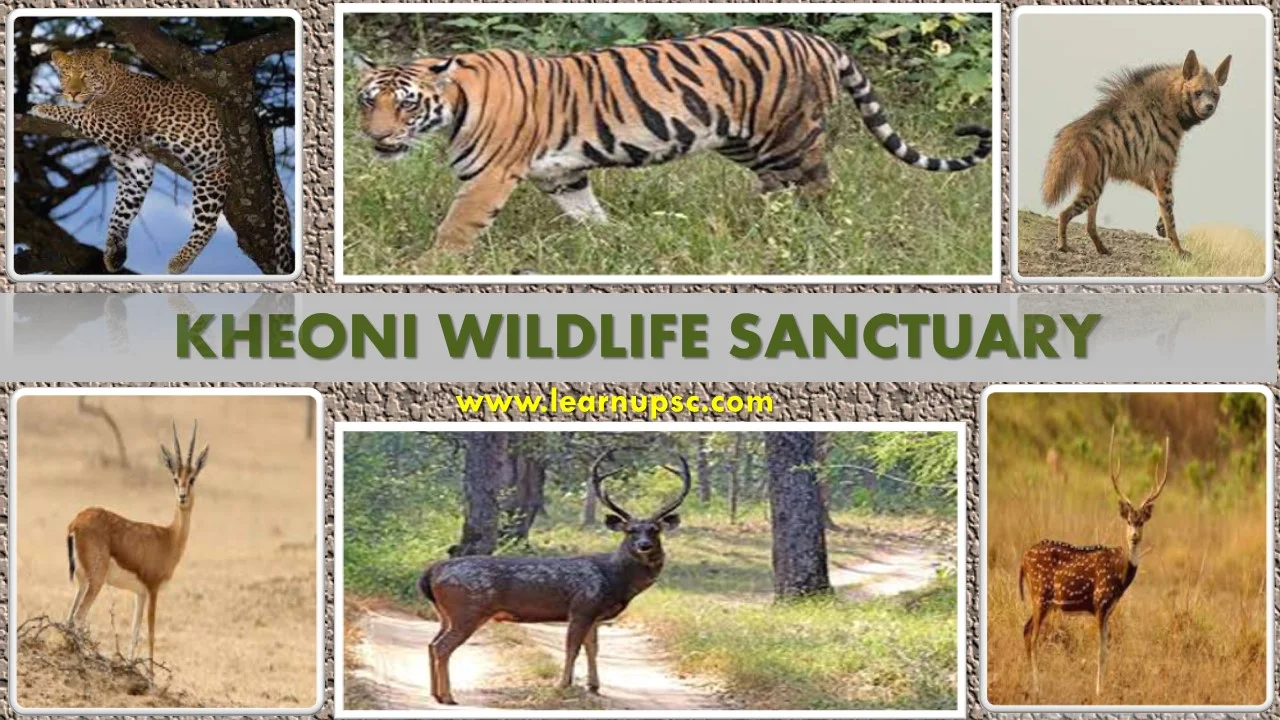Kheoni Wildlife Sanctuary UPSC
Kheoni Wildlife Sanctuary is a protected area located in the state of Madhya Pradesh, India.
The sanctuary's importance extends beyond its boundaries as it serves as a corridor connecting the Satpura Tiger Reserve and the Melghat Tiger Reserve, facilitating wildlife movement and gene flow.
Kheoni Sanctuary supports an array of avifauna, with approximately 125 bird species documented, including the Indian paradise flycatcher and plum-headed parakeet.
|
Table of Contents
|
Kheoni Wildlife Sanctuary Location
Kheoni Wildlife Sanctuary is located in the Kannod Tehsil of Dewas district and parts of Sehore district in Madhya Pradesh, India. The sanctuary is in the central part of India, within the southern tropical dry deciduous region.
Nearest Airport:
Devi Ahilya Bai Holkar Airport in Indore, Madhya Pradesh, India. It is approximately 75-80 kilometers away from Kheoni Wildlife Sanctuary.
Nearest Railway Station:
Indore Junction is the nearest major railway station to Kheoni Wildlife Sanctuary. It is located in Indore, Madhya Pradesh, India. The distance from Indore Junction to Kheoni Wildlife Sanctuary is approximately 80-85 kilometers.
Kheoni Wildlife Sanctuary History
Kheoni Wildlife Sanctuary was established in the year 1974. The sanctuary has had nearly five decades of existence, serving as a protected area for wildlife conservation and biodiversity preservation in the region.
Kheoni Wildlife Sanctuary Area
Kheoni Wildlife Sanctuary is spread over an area of approximately 132 square kilometers. With an area of 132 square kilometers, Kheoni Wildlife Sanctuary provides a significant habitat for various wildlife species.
Kheoni Wildlife Sanctuary River
Kheoni Wildlife Sanctuary is the origin of two rivers: Jamner and Balganga. These two rivers are tributaries of the Narmada River. The sanctuary serves as the starting point for the flow of Jamner and Balganga rivers, which eventually join the Narmada River.
These rivers are crucial for providing water to the wildlife in the sanctuary, especially during the dry summer months when water sources may become scarce. Additionally, the presence of rivers contributes to the overall biodiversity and ecological significance of the sanctuary, as they support various aquatic and terrestrial species and create diverse habitats for wildlife.
Kheoni Wildlife Sanctuary Flora
Kheoni Wildlife Sanctuary is characterized by a dry deciduous forest dominated by various plant species typical of the southern tropical dry deciduous region of India. Some of the key flora found in the sanctuary include:
- Teak (Tectona grandis)
- Tendu (Diospyros melanoxylon)
- Bamboo
- Salai (Boswellia serrata)
- Dhawda (Anogeissus pendula)
- Amla (Phyllanthus emblica)
- Harra (Terminalia chebula)
- Ber (Ziziphus mauritiana)
- Bel (Aegle marmelos)
- Palash (Butea monosperma)
Kheoni Wildlife Sanctuary Fauna (Kheoni Wildlife Sanctuary Animals)
Kheoni Wildlife Sanctuary is home to a diverse range of fauna, including various mammals, birds, and other wildlife species. Here are some of the notable fauna found in the sanctuary:
Mammals:
- Tigers
- Leopards
- Jungle Cats
- Jackals
- Striped Hyenas
- Nilgai
- Blackbuck
- Chinkara
- Chital
- Sambar
- Wild Boar
- Barking Deer
- Four-Horned Antelope
- Palm Civet
Birds:
- Indian Paradise Flycatcher
- Plum-headed Parakeet
- Eurasian Collared Dove
- Laughing Dove
- Chestnut-shouldered Petronia
- Common Crow
- Black Drongo
Reptiles:
- Indian Rock Python
- Russell's Viper
- Common Cobra
- Indian Monitor Lizard
- Common Indian Skink
- Fan-throated Lizard
- Indian Chameleon
- Indian Garden Lizard


No comments:
Post a Comment